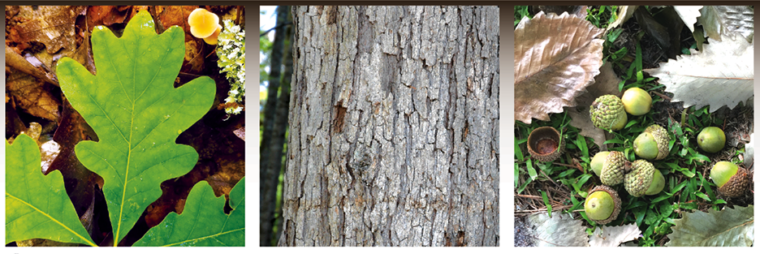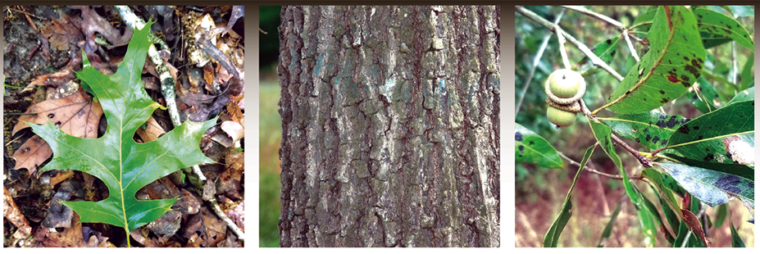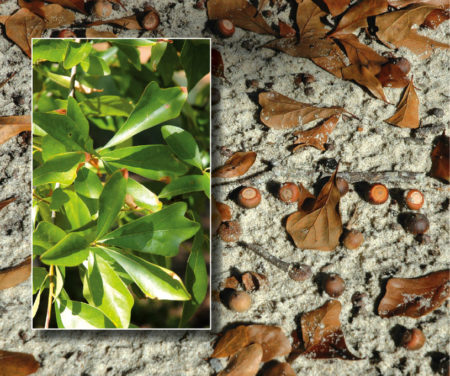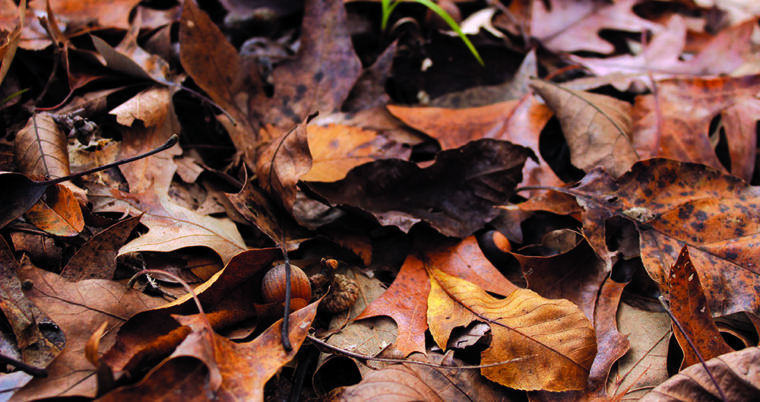Identifying a white oak raining acorns in early bow season is a straightforward approach to putting backstraps on the grill, but this only works a couple short weeks of the year. Learn to play the acorn pattern all season long.
The mid-January afternoon was hot, and mosquitos buzzed by my head as I leaned against a willow oak on a small peninsula extending into the swamp, deep inside a piece of Mississippi public hunting land. My anticipation was high, as I had observed lots of deer sign in the leaf litter surrounding my hunting location. Soon, does, fawns, small bucks, and a heavy antlered 6-pointer began milling around the oak flat I was hunting. I didn’t harvest a deer that evening, but not for lack of opportunity. The key to putting myself within range of several deer on that hunt was my scouting. But at a deeper level, it was my understanding of oak ecology and applying that to my prior observations, which affored me this encounter with several deer – even after three and a half months of heavy hunting pressure on public ground.
While being able to identify pinch points, bedding areas, soft mast and oak trees are important scouting skills, understanding the ecology and physical characteristics of oaks is imperative to developing a hunting strategy for the entire season. Sure, identifying a white oak raining acorns in early bow season is a straightforward approach to putting backstraps on the grill, but this only works a couple short weeks of the year. In this article, I’ll breakdown some basic characteristics of oaks and differences between species that can improve your hunting strategy from the beginning of deer season to the bitter end.
Ups and Downs of Oak Reproduction
Oaks produce acorns high in fats and carbohydrates, making them an excellent energy source. Obviously, these seeds are produced by oaks to produce oak seedlings that will eventually grow into new adult trees. However, because acorns are high in energy and easily digested by many wildlife species, they are heavily predated, and so oaks must have a strategic acorn production cycle to offset this acorn loss to seed predators like deer.
Oaks are cyclical producers: they do not produce large crops of acorns every year but produce acorns in a boom-and-bust fashion. In fact, oaks commonly will go a year or two without producing any acorns, while other years they produce massive crops. Much research has shown that this cyclical acorn production causes feast and famine cycles for small mammals like squirrels and mice that rely heavily on the acorn crop. When oaks have a bust year and produce little or no food, small mammals experience population crashes because there is not enough food. But when oaks produce a large acorn crop, the small remaining population of acorn predators is unable to effectively eat all of the acorns, and more seed survives to germinate into seedlings.
Besides the natural cycle of acorn production, there are other factors that affect whether or not a tree produces acorns. These include rainfall, air temperature, winter severity, and wind patterns during pollination. For example, a late spring frost can kill oak flowers and wipe out a future crop of acorns. Likewise, a poorly timed drought can stress trees and reduce the acorn crop. It is important when scouting and developing your hunting strategy to understand this variability in acorn production so you can adapt.
Get to know Oak Groups
Oaks native to North America are divided into two main groups: white oaks and red oaks. There are several important differences in life history traits between the two groups, mainly in acorn production cycles and characteristics of their acorns. Red oak flowers produced in spring develop into mature acorns a year and a half later, but white oak acorns develop much more quickly and mature the fall immediately after their flowers bloom. Because of this difference in development timing, it’s not uncommon for trees in one group to have a bumper crop and trees in the other group to experience a mast failure the same year. For instance, if a late frost in spring kills the white oak crop, red oaks may still produce a large crop if the conditions the prior year were favorable. This creates a buffer effect for wildlife species, because in any given year there is usually at least one species that produces acorns.

The white oak group can generally be identified by leaves with rounded, smooth lobes and bark that is lighter or “white” in color, and the bark tends to be flaky. Left: white oak leaf. Center: white oak bark. Right: swamp chestnut oak acorns and leaves.
White oak acorns follow this same accelerated approach by germinating quickly after they hit the ground. In fact, it’s not uncommon for their acorns to germinate within a day or two of falling if there is adequate moisture, making them unavailable to deer. Red oaks on the other hand persist through winter on the ground and do not germinate until spring, making them an excellent winter food source.

The red oak group can generally be identified by leaves with bristles on the tips of the lobes and bark that is darker and more compact or firm than bark in the white oak group. Left: scarlet oak leaf. Center: northern red oak bark. Right: willow oak acorns and leaves.
Because red oaks must survive on the branch or ground for a long period of time, they contain more tannins than white oaks. This makes white oak acorns much more digestible and highly selected by deer and other wildlife species than red oaks. As a result, many hunters completely write off red oaks and only focus on white oaks as a food source to hunt. This is a major oversight, because red oaks can be a dynamite food source late in the season.
Oak Identification
There are dozens of native oak species in the Southeast, Northeast, and Midwest so it’s hardly worth while to identify them in this article. However, there are several identification characteristics I will describe through examples to better equip you to identify oak species unique to your area.
Red oaks can be distinguished from white oaks by leaf and bark characteristics. The lobes on red oak leaves have a well-defined bristle on the tip, and white oak leaves have rounded, smooth lobes. This is the single most distinguishing characteristic between these two groups, but keep in mind when examining a tree’s leaves that there is always variability and exceptions. So, take your time and examine several leaves from the same tree.

Trees in the red oak group like water oaks (leaves and acorns seen here) produce acorns that are less attractive to deer than white oak acorns but last much longer on the ground. Thus, red oak acorns can become late-season food sources that produce good hunting opportunities long after white oak acorns have disappeared.
There are also subtle differences in the bark between both groups. Red oak bark tends to be darker and more tightly furrowed than white oaks’, which are often lighter colored and flaky. However, because of the wide variability in bark among species, this characteristic is less defined than the bristle tips on leaves.
Using these two characteristics to distinguish between both groups will allow you to formulate a basic hunting strategy without identifying trees by species. However, if you want to really take your hunting strategy to the next level you should strive to learn as many oak species as possible; I suggest beginning with white, chinkapin, scarlet, and black oak which are common species across much of the eastern United States. For southern hunters I also suggest learning swamp chestnut, live, southern red, willow, water, cherrybark, and Shumard oaks. Hunters in more northern latitudes should learn burr, pin, northern red, and shingle oak.
Set Your hunting Strategy
Using this background in oak ecology to develop a season-long hunting strategy will not only make you a more successful hunter, it will also increase your satisfaction when harvesting a deer because you will develop a closer relationship with the natural world. Scouting oaks in summer to determine which are producing acorns is the best way to prepare for hunting over acorns. As I mentioned before, oaks are very cyclical in their acorn production. Often, because of synchronized flowering in individuals across a species, you can observe a few trees and get a good idea for how successful an acorn crop that species produced that year. By doing this, you can somewhat accurately predict acorn production of trees you’ve hunted in the past just by observing regional acorn production trends of that species.
While observing acorn production over multiple years, be aware that genetics affects the number of acorns each tree produces, along with the environmental factors mentioned earlier. A study by Dr. Marcus Lashley and his co-researchers examining masting characteristics of white oaks in Tennessee and North Carolina found that a third of the white oaks in a stand produced 75 percent of the total acorn crop, showing the importance of genetics to acorn production potential of individual trees. Based on the importance of tree genetics, you should closely follow which trees produce the most acorns over multiple years to identify high-odds hunting opportunities for the future.
On a management-minded note, many landowners have suggested that fertilizing oaks will increase acorn production and attractiveness. However, research conducted by Jarred Brooke and Dr. Craig Harper in eastern Tennessee disproved this popular belief. For much more on their research and what they learned about the best technique for increasing acorn production among oaks, read the article that follows mine.
Deer quickly change their focus between trees, causing spots to go cold overnight. Be mobile and make changes if you wish to remain an effective hunter throughout the season.
Once you have identified trees you plan to hunt, think about timing of acorn availability for each species. Which oak species are present and the resulting hunting strategy will depend on the forest type you are hunting. In bottomland hardwood forests, target swamp chestnut oak and white oak early, before they germinate, while they are being hammered by deer. As hunting season progresses, you will want to shift your focus to species in the red oak group, whose acorns will be available through winter. Shumard oak, for example, is a very late producing species that usually will not drop its acorns until November or December, making it an exceptional late-season food source. Cherrybark, water and willow oak are also species worth watching through winter. While they do not produce exceptionally large acorns, they are very prolific, and I have had many successful late-season hunts under these trees. In upland hardwood stands, you should seek out white oaks for early-season hunting. Late-season strategy should focus around red oaks like southern red, scarlet, and northern red oak.
The basic strategy I’ve laid out here focuses on the timing of acorn availability and identification of strong producing trees to effectively exploit the characteristics of acorn masting for deer hunting. You should also be mobile and make changes as deer switch preferred trees if you wish to remain an effective hunter throughout the season. Deer quickly change their focus between trees, causing spots to go cold overnight as deer shift from one tree to the next. I’ve observed this most often in early season when deer are hammering white oaks. If a new tree begins dropping fresh acorns, deer often switch to the fresher mast, which is likely more attractive than acorns that have been lying on the ground and may be germinating.
Observe and Succeed
This article has outlined the basic ecology of oaks and differences between them. This information can help you develop a successful hunting strategy that will keep you in the game throughout the whole hunting season. The key to unlocking the potential of hunting acorns is making detailed observations in the field, experimenting with your strategy, and determining what tactics work best. Developing a hunting approach that targets natural food sources like acorns forces you to understand the relationship between deer and their habitat, improving your woodsmanship and your satisfaction with a successful harvest.
